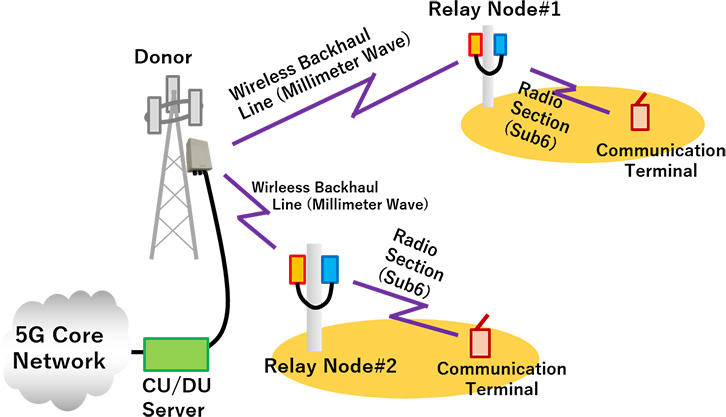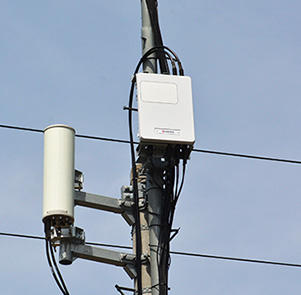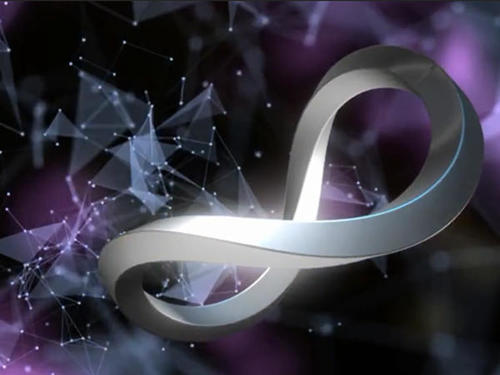KYOCERA Corporation ("Kyocera") and SoftBank Corp. ("SoftBank") conducted a backhaul system verification test utilizing the millimeter-wave band allocated to SoftBank for 5G (referred to as "5G millimeter-wave") at SoftBank base stations located in Akiruno City, Tokyo, from January to April 2022. This system used a 5G millimeter-wave to connect a backhaul link between a donor station and a relay node station that constitutes the access area. The donor station conformed to the O-RAN Alliance* fronthaul specifications that connect to the network. In view of the demonstration test results, Kyocera and SoftBank are pleased to announce that they successfully verified stable communications and system effectiveness.
Outline of the Demonstration Experiment

Structure of the Demonstration Experiment
Experiment Results
Through this demonstration, Kyocera and SoftBank confirmed that a backhaul system utilizing 5G millimeter-wave would contribute to shortened construction periods and cost reductions through efficient use in areas where 5G networks are difficult to install due to challenges such as topography. Both companies also confirmed that 5G millimeter-wave technology could be a new means of communication between base stations and terminals.
Future Developments
Kyocera and SoftBank will continue to consider how to address issues such as lowering power consumption and operational automation. Both companies will also consider systems that can be applied to various needs in Japan and overseas.
*The O-RAN Alliance, which stands for "Open Radio Access Network Alliance," is an industry group dedicated to making 5G and other next-generation wireless access networks more open and intelligent.

Donor Station

Relay Node Station
Outline of the Demonstration Experiment
| Term | January - April 2022 |
| Place | Akiruno City, Tokyo |
| Purpose | Used a 5G millimeter-wave backhaul system test to: ・Verify the effectiveness of millimeter waves as a backhaul line ・Establish end-to-end communications from the CU (Centralized Unit, aggregation node) / DU (Distributed Unit, distributed nodes) server to the communication terminals ・Confirm the effects of weather changes such as rainfall and snowfall ・Collect data for the development of commercial products conforming to O-RAN Alliance specifications, etc. |
| Content | ・Two relay node stations: one 260m away and another 1,270m away from the donor station, were installed. ・Connected the 5G millimeter-wave as a backhaul line. Conducted connection tests from the 5G core network server to the communication terminals via CU/DU, donor station, and relay node station. |
| Results | ・Verified end-to-end connectivity from the CU/DU server to the communication terminals. ・Confirmed that a backhaul system utilizing a 5G millimeter-wave could stably connect at a 1 km distance or more from a donor station. In addition, it could be connected not only in fine weather but also in case of rain or snowfall. |

Structure of the Demonstration Experiment
Experiment Results
Through this demonstration, Kyocera and SoftBank confirmed that a backhaul system utilizing 5G millimeter-wave would contribute to shortened construction periods and cost reductions through efficient use in areas where 5G networks are difficult to install due to challenges such as topography. Both companies also confirmed that 5G millimeter-wave technology could be a new means of communication between base stations and terminals.
Future Developments
Kyocera and SoftBank will continue to consider how to address issues such as lowering power consumption and operational automation. Both companies will also consider systems that can be applied to various needs in Japan and overseas.
*The O-RAN Alliance, which stands for "Open Radio Access Network Alliance," is an industry group dedicated to making 5G and other next-generation wireless access networks more open and intelligent.





